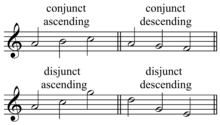|
Melodic motion Melodic motion is the quality of movement of a melody, including nearness or farness of successive pitches or notes in a melody. This may be described as conjunct or disjunct, stepwise, skipwise or no movement, respectively. See also contrapuntal motion. In a conjunct melodic motion, the melodic phrase moves in a stepwise fashion; that is the subsequent notes move up or down a semitone or tone, but no greater. In a disjunct melodic motion, the melodic phrase leaps upwards or downwards; this movement is greater than a whole tone. In popular Western music, a melodic leap of disjunct motion is often present in the chorus of a song, to distinguish it from the verses and captivate the audience. In traditional culture musicEthnomusicologist Bruno Nettl describes various types of melodic movement or contour to categorise a song's melody. There are three general categories, ascending, descending, and undulating:[1]
According to Nettl, undulating and descending melodies are far more common than ascending ones.[2] He also identifies additional specialized types which characterise musical styles with exceptionally homogenous contours, named after the melody contour's trace.[3]
In addition to this, rise, which may be considered a musical form, is a contrasting section of higher pitch, a "musical plateau".[4] Other examples include:
These all may be modal frames or parts of modal frames. See alsoCitations
Bibliography
Further reading
|